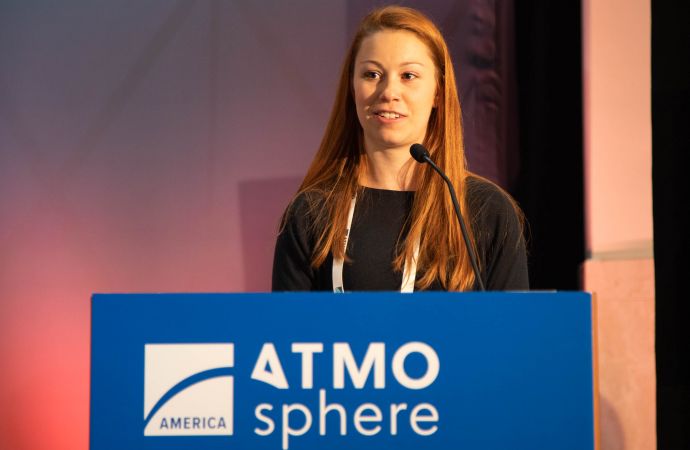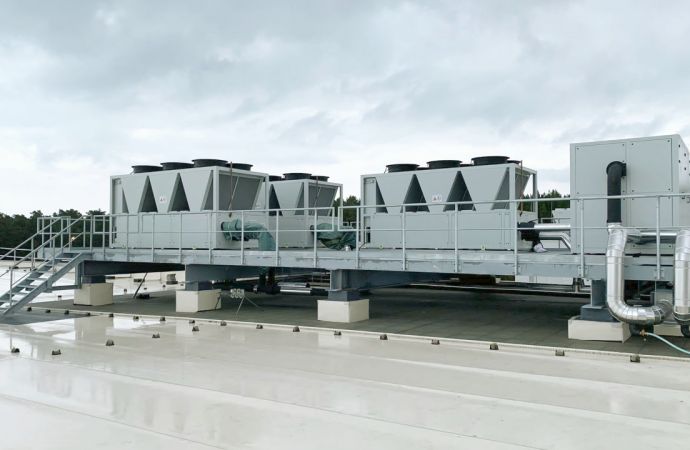Efficiency Vermont provides funds to Hannaford for CO2 and R290 equipment and to a food bank for a transcritical system.

Ali White at ATMOsphere America.
Efficiency Vermont, an efficiency utility under the auspices of the nonprofit Vermont Energy Investment Corp. (VEIC), has begun giving customized financial incentives for natural refrigerant systems implemented in the state, including $100,000 to the Hannaford Bros. for a new supermarket and $50,000 to a food bank.
Efficiency Vermont, funded by Vermont utility rate payers, is also planning to launch incentive programs for self-contained cases using hydrocarbon refrigerants and for leak repair. And it is developing a test of CO2 condensing units – rarely used in the U.S. – in a variety of applications.
The Hannaford store, in South Burlington, Vt., which is expected to open early next year, will employ a transcritical CO2/glycol chiller for mediumtemperature cases and propane (R290) low-temperature self-contained cases (Hussmann’s microDS line). Hannaford has been testing these technologies in new stores as a path to using them to retrofit existing stores. (See “R290: The Future of Retail Refrigeration,” Accelerate America, January 2019.)
“We were able to calculate energy savings associated with optimizing the [CO2 system’s] adiabatic gas cooler,” including lowering compressor head pressure, said Ali White, energy consultant for VEIC, who described Efficiency Vermont’s natural refrigerant programs in a presentation in June at the ATMOsphere America conference in Atlanta, Ga., U.S. “Between that optimization and the low-temperature system, we were able to give a $100,000 incentive.” The energy savings amounted to 650 MW-hrs which is expected reduction of 2.5 million lbs of CO2e emissions, compared to an R507 baseline.
Efficiency Vermont is also working with Hannaford on leak monitoring and repairs to reduce fugitive emissions of high-GWP refrigerants, said White. The utility plans to launch a prescriptive (deemed) incentive program for leak repair early in 2020.
Now we’re focusing on incentivizing hydrocarbon self-contained cases at the distributor level."
– Ali White, VEIC
At the food bank, which uses a transcritical CO2 refrigeration system, Efficiency Vermont awarded $50,000 based on an annual savings of 270 MW-hrs, she said.
Self-contained hydrocarbon cases represent an area of growing interest for Efficiency Vermont, said White. “Now we’re focusing on incentivizing hydrocarbon self-contained cases at the distributor level." The utility is targeting a mid-fourth-quarter rollout of a deemed program.
The utility is also studying ways to incentivize existing stores that employ “drop-in” low-GWP refrigerants to replace high-GWP or ozone-depleting refrigerants, White noted. “There are not a lot of new stores in Vermont, so we’re metering those conversions this year to see if there’s an energy savings.”
Interest in CO2 condensing units
This year, Efficiency Vermont has also been developing plans to test CO2 condensing units for supermarkets, dairies, cheese makers and breweries, which would be among the first such installations in the U.S. (See “Vermont to Test CO2 Condensing Unit,” Accelerate America, January 2019.)
Effficiency Vermont has recruited a dairy farm and four equipment manufacturers for the program so far. Other manufacturers are welcome to apply, she noted. The dairy farm would use the CO2 condensing unit to cool its milk bulk tanks as well as employ heat recovery to preheat its clean-in-place water.
The utility plans to have at least one system installed by the first quarter of 2020, said White. The pilot will measure the energy efficiency of CO2 condensing units in comparison with that of HFC units in order to justify financial incentives for purchasers of the CO2 system. Dairies, breweries and stores in Vermont tend to be small, noted White, making remote condensing units a viable refrigeration option. CO2 condensing units, which also provide ample heat recovery, are “really attractive to us.”
CO2 condensing units, while widely employed in Europe and Japan, are rare in the U.S.
Related stories



